- by New Deal democrat
For the last decade I have made a specialty of observing "long leading indicators" -- those metrics that turn at least a year before the economy as a whole does -- and of historical indicators that date as far back as the 1910s.
That specialty is particularly relevant in discussing the current obsession with the shape of the yield curve, slicing and dicing the modern data as it relates to the Fed funds rate, 3 and 6 month Treasuries, 2 year Treasuries, 10 year Treasuries, and the inflation rate.
Why? Because historically a yield curve inversion is not a necessary precursor to a recession.
To begin with, the Fed did not begin making use of the Fed funds rate until 1954. The Fed itself didn't exist until 1914, and for the first 40 years of its existence only made use of the discount rate, which itself was not made uniform nationwide until 1935.
And the Fed funds rate did *not* exceed the 10 year Treasury yield prior to either the 1957 or 1960 recessions. The first time that measure of the yield curve did invert was in 1965, which presaged a steep slowdown in 1966 which did not quite qualify as a recession:
So, next, let's compare the discount rate with long term government bonds going all the way back to the 1920s (the modern 10 year treasury data is also shown in green to show the very close correspondence between it and the archival series):
With the exception of the "great contraction" of 1929-32, the yield curve measured this way never inverted before 1959. That's *5* recessions which waiting for a yield curve inversion would have missed.
We also have data on short term government bonds in the 3-6 month range going back to the 1920s as well. Here's what they look like compared to long term bonds:
Again, no inversions whatsoever between 1929 and 1959, although it did come close, but did not invert, prior to the 1927 and 1957 recessions.
Finally, a number of commentators are stressing the necessity for the Fed funds rate to exceed the inflation rate for a recession signal. We can examine this, using the discount rate, going all the way back more than 100 years:
There are problems both ways with this argument. On the one hand, the Fed funds rate exceeded the inflation rate for most of the 1920s, 1960s, 1980s, and 1990s -- in short, the most prosperous decades during the last century! On the other hand, the Fed funds rate did *not* exceed the inflation rate prior to the 1918, 1920, and 1949 recessions -- and was moving the "wrong way" prior to the 1957 recession!
In short, once we go back before 1960 -- i.e., a low interest rate environment very similar to the one we have been in for the last decade -- although a yield curve inversions is very bad (1929!), neither an inversion nor a "tight" real Fed funds or discount rate is necessary at all for a recession to occur.
While it is far too long to get into here, here are several other historical graphs to consider.
First, the annual rate of nonfarm housing starts, dating all the way back to the 1800s:
Second, the monthly rate of nonfarm housing starts dating back to 1945 (and continuing through the 1960s to show that they accord very closely with the modern housing starts series, also shown):
The archival annual housing starts series turned negative during the year in which recessions began 11 out of 14 times. The archival monthly series turned negative before all 4 post-WW2 recessions leading up to and including 1960.
A detailed historical consideration of housing is far too long for this post. But consider that the common thread, going back almost 150 years, appears to be that something happens in the economy to cause consumers to pull back on their purchases of important durable goods like houses, of which the Fed raising interest rates (and inverting the yield curve) may only be one cause.



















